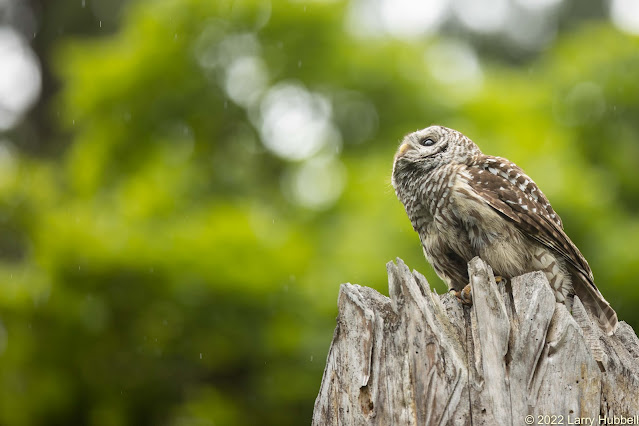Here is a recent post from the Union Bay Watch Blog published by Larry Hubbell, long-time local photographer and birder.
Owlet Tails
Very young Barred Owls are incredibly cute and very vulnerable. When they first leave the nest they are typically unable to fly. While learning, they often fall to the ground where they are easy targets for coyotes, raccoons, and even off-leash pets.
Their only escape is to waddle to the base of a tree and claw their way up - one vertical step at a time. Their sharp talons help them to essentially walk up the tree trunk. This is a slow, intense process. They often stop to rest. Occasionally, they resort to using their bills to help facilitate their ascent.
I suspect this young owlet was using its wings for balance not lift. (This was my first time seeing a tree-hugging Barred Owl.)
Ultimately, the young owl crawled up to a sizable horizontal branch. Large, level branches hidden below a thick upper canopy are one of the safest places for a young owl to hang out. They also make nice tables. In the Arboretum, the mid-level branches on Big Leaf Maples trees are often used by Barred Owls, Cooper's Hawks, and Common Ravens as dining platforms.
The short, white-trimmed feathers, towards the center of the bird, are the owlet's tail. I am guessing the tail is maybe an inch or two long. I do not know the exact pace of rectrices growth. However, later in this post, we will see photos that imply rapid lengthening of the tail feathers once the young leave the nest.
The parents actively watch out for their young.
In this case, the adults paid particularly close attention to a Cooper's Hawk that was calling loudly from the nearby trees.
Finally, one of the adult owls grew impatient and chased the noisy young hawk away.
This particular young Cooper's Hawk was banded near its natal nest in Miller Park last July. Thank you to Martin, Ed, and Patti who lead the Urban Raptor Conservancy. They have been banding raptors in the city for years while developing and sharing an incredible wealth of knowledge. To learn more visit their website: Urban Raptor Conservancy.
The young owl turned and walked toward the parent.
Often both parents were in the tree but they do need to leave to find food.
Can you tell what is on the menu? (The answer will be mentioned below.)
Owlets need a nearly constant supply of food. They don't seem to be particular about the species.
After a few exploratory bites, the young owl attempted to just swallow the body of the bird.
Don't try this at home. We are simply not equipped for this approach to food consumption. It does make eating much faster and safer for predators. They rapidly internalize their food, leaving digestion for later and freeing them to escape harassment.
Repeatedly, the owlet threw its head back. Slowly, one millimeter at a time, the Spotted Towhee's body began its final descent.
Bones, meat, feathers, and feet all go down together. The indigestible parts will be regurgitated later.
***********
Thank You to everyone who has provided tips that helped me find the owlets. The list includes Roy, Ron, Tom, Bethany, Mindy, and Dan. (If I have omitted your name please excuse my memory lapse.) All your help is truly appreciated!
***********
A week later I finally found two more young owls that belonged to the pair of Barred Owls in the next territory to the north.
Notice that this young owl's tail is considerably longer than the owlet in the previous photos even though it is still molting out of its youthful fluffy white feathers.
I am guessing it has been out of the nest for at least three or four weeks. It is already flying, but learning to hunt will take sometime.
When its parent caught breakfast the adult ate most of the meal before picking up the leftovers and looking for the juvenile owl.
The young owl accepted the food readily. The meager offering did not appear to be enough to satiate its hunger. The adult must walk a fine line between helping the young one to survive and not reducing its motivation to hunt. By winter, the young will be on their own and their survival will be determined primarily by their hunting skills.




















No comments:
Post a Comment